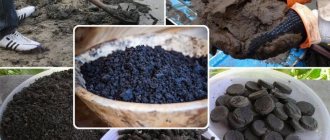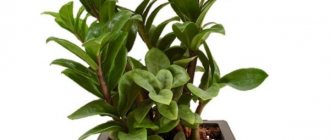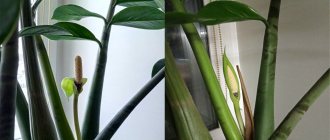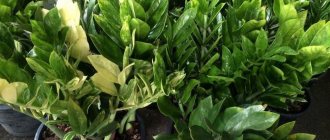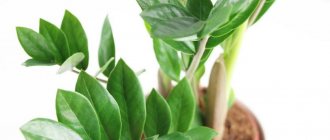Discovered in the tropical forests of Africa, the beautiful Zamioculcas attracted the attention of botanists with its succulent, fleshy leaves. In recent years, it has become very popular, especially after it became known that according to Feng Shui, this flower brings good luck and financial well-being to its owners. Then it was quickly nicknamed the dollar tree and began to be given as gifts for birthdays, holidays, and to decorate offices.
The genus Zamioculcas belongs to the Araceae family. And there is only one species - Zamioculcas zamiifolia (1). However, other types can be found in the literature. For example, Zamioculcas lanceolata - it was described by the German botanist Gustav Peter in 1929, but at the moment it is classified as Zamioculcas similefolia. And Boivin's zamioculcas (Zamioculcas boivinii), which was described in 1870, is now classified as a completely different genus - Gonatopus boivinii.
This plant was first described in 1829. However, it became widespread quite recently - in 1996 (2), when Dutch nurseries began to actively propagate it.
With good care, the dollar tree reaches a height of 1 m or more. It blooms quite rarely, and its light pink or light yellow spadix is not particularly decorative. But the fleshy dark green leaves can delight you all year round. The chairman of the Moscow Flower Growers club, a collector of ornamental flowering plants, Tatyana Zhashkova, told us about the features of this plant
Dollar Tree Varieties
Zamioculcas is very popular not only with flower growers, but also with breeders - they have developed several interesting varieties.
Big Liv yellow (Big leaves var. yellow). This is a very rare variety of Zamioculcas with yellow leaves. At first glance, it seems that the plant is sick and is about to shed its leaves. But no - this is its varietal feature. But its petioles are light green with a purple tint, which makes it even more exotic.
Bug. This is the smallest of all existing varieties - its height does not exceed 30 cm. Its petioles are leafy from the very base, the leaves are dark green.
Zamicro. The very first short hybrid, obtained by breeders in 2007. The height of the bush is about 60 cm. The leaves are much smaller than those of the species plants.
Zenzi. Another low-growing variety - its height also does not exceed 60 cm. The petioles of the leaves are very thick at the base, and the leaves themselves are dark green in color. The variety cannot tolerate waterlogging - it must be watered very carefully.
Lucky. Its main feature is the perfectly rounded shape of the leaves. The plant is up to 55 cm high, grows very quickly - with good care it reaches the size of an adult plant in just a matter of months.
Lucky White (lucky white). This is the most famous variety of the variegated series. Its leaves have a beautiful marble color - cream and yellow spots and streaks are scattered across the green background. The plant is compact, 30 - 40 cm high.
Super Nova. This variety is a luxurious giant up to 1.5 m high. Its petioles are powerful, with an abundance of emerald green leaves.
Black Raven. Its leaves and shoots are so dark in color that from a distance they appear black. At the same time, young leaves are colored light green. The plant looks very extravagant! The bush reaches a height of 75 cm.
Caring for a dollar tree at home
In general, Zamioculcas is an unpretentious plant, but there are several growing features that need to be taken into account.
Priming
Zamioculcus is a succulent plant, so soil marked “for cacti” is suitable for it.
But you can prepare the soil yourself. The ideal option is a mixture of leaf and turf soil, peat and sand in a ratio of 1:1:1:1. It is useful to add small pebbles and pieces of charcoal to it.
Temperature
During active growth, the air temperature should not be lower than 18 °C, but optimally 25 °C. But in winter, the plant enters a dormant period, and at this time it needs coolness - around 16 °C.
Lighting
The dollar tree loves plenty of light, but does not tolerate direct sunlight - it can cause leaf burn. In summer, this plant feels great on a glassed-in loggia, provided that the sun does not shine directly on it.
Humidity
Zamioculcas has a tuberous root; it is capable of storing water, so it easily tolerates underwatering and drought. It lives quietly without watering for up to 2 weeks - you can safely leave it when going on vacation, or leaving the office for a long vacation.
Zamioculcas is a plant that does not require special care. Photo: @mrlokeshtiwari, pexels.com
But he doesn’t like overflow. If the water sits in the pan, the tuber root may rot. Therefore, drainage and moderate watering are very important. It is necessary to water only when the top layer of soil dries very well.
But at the same time, the dollar tree loves moist air, so it needs to be sprayed every day. It’s even better if it is in a room where there is a humidifier. This is especially true in winter, when the plant stands above a heating radiator.
Fertilizers and fertilizers
Zamioculcas needs feeding only during the period of active growth - from April to September. It is best to use complex liquid fertilizers. There is no need to fertilize it during dormancy.
Rules and features of Zamioculcas reproduction
The situation when a plant is flooded or overdried, the root has rotted, the rachis has softened or shriveled, happens even to experienced gardeners. The remaining parts should not be thrown away in a hurry, since you can propagate a dollar tree at home with any healthy part.
When to breed Zamioculcas
It is better to root stem-like rachis, leaf cuttings, divide into parts or plant tubers in the spring. It is then that growth processes are activated, and the operation is likely to end in success. When Zamioculcas is bred at the beginning of the season, new roots appear relatively quickly.
During the dormant period they will form much more slowly. There is a danger of attacks - the leaves will dry out or rot before they have time to produce a small, onion-like tuber. In autumn and winter, roots take longer to recover after transplanting or dividing and suffer more from waterlogging.
If Zamioculcas dies, reproduction is carried out regardless of the season. It will simply become much more difficult to care for planting material; there will definitely be attacks.
Substrate for reproduction
After division, the rhizomes are planted in the soil that the owners use for adult zamioculcas. The pot just needs to be smaller than before.
Read how to prepare soil for zamioculcas here.
Leaves that have been cut can be placed in water or planted. The roots will germinate well in a light substrate or one consisting only of mineral components. You can take:
- coarse sand;
- perlite;
- a mixture of baking powder with peat or ready-made soil for cacti (1:1).
Sand should be taken only in large fractions - at least 2 mm. A small one is unsuitable for propagation - it will definitely bunch up or stick together.
Vermiculite is generally not suitable for cuttings of Zamioculcas. It can be used to germinate violets, ficus, garden ornamental crops, but succulents that do not require scanty watering.
Vermiculite has a colossal moisture capacity - 400-530%, that is, it absorbs 4-5.3 times more water than it weighs. And then he gradually gives it away.
Cuttings can be destroyed not even by waterlogging, but by regular, timely watering. That is why when Zamioculcas is propagated by leaf fragments, there is a high percentage of attacks. Vermiculite increases it several times.
Rooting containers
You can grow cuttings in common containers - they must be wide to accommodate many leaves, and flat, otherwise the risk of waterlogging increases. It is not recommended to plant fragments in a large pot.
If there is enough space in the house, it is better to keep the cuttings in individual plastic cups:
- through the transparent walls you can see how Zamioculcas is sprouting roots;
- when new rachises begin to emerge, they can be allowed to get stronger, and not planted immediately, so that the sucking shoots do not become intertwined.
When will the cuttings grow into a full-fledged plant?
A zamioculcas cutting placed in soil or a light mineral substrate will first grow roots and then produce a small tuber.
Between rooting and the appearance of the first sprout a lot of time will pass, and the longer the smaller the division.
It is impossible to determine the exact date for the appearance of zamioculcas babies, but flower growers need to focus on something so as not to sound the alarm ahead of time:
- when planting a whole rachis without a root, a new stalk will come out in 2-6 months;
- Zamioculcas, when propagated by leaves cut into fragments or segments, will begin to grow a rachis similar to a small twig after 6 months or a year.
The only way to speed up root germination is with stimulants. When they appear, you just need proper care, you can’t give any fertilizers - this will only lead to problems, and it won’t go faster anyway.
Reproduction of a dollar tree at home
There are three ways to propagate the dollar tree (Zamioculcas).
By dividing the tuber. The easiest way to propagate a dollar tree is by dividing the tuber. When transplanting an adult plant, the tubers are separated and planted in different pots. The pot for the separated tuber should not be very deep and not very large - about 3 - 4 cm wider than the rhizome.
By cuttings. Cuttings are a more labor-intensive task. First you need to find a bud on a bare branch. Using a sharp knife, cut off the stem with the bud and shorten it slightly - there should be at least one leaf and a bud on the stem. The cut should be sprinkled with activated carbon to disinfect it from possible diseases. Dry the cuttings for 5 - 7 hours (you can leave them on the windowsill overnight).
Pour vermiculite (a special substrate saturated with minerals) into a small pot and slightly deepen the cutting. Water it every day for 2 - 4 weeks, during which time the cutting should give good roots. And then it can be transplanted to a permanent place.
Leaf. A simple, but not always 100% effective method. Moreover, it takes a very long time. Separate several small leaves from the branch, slightly deepen them into loose vermiculite, peat or other substrate. Moisten it a little.
Such “leafy” seedlings need good lighting. You can create a greenhouse effect by covering it with film. The tuber from the leaves forms over several months.
Is it possible to prune Zamioculcas?
Before answering the question, it is necessary to define the operation. And then relate it to culture. Because pruning a dollar tree is possible, both from the point of view of botany and practical gardeners. But these will be different actions.
What is pruning
Plant pruning is the targeted removal of branches, shoots, buds or roots. Vegetative organs can be removed completely or partially. Leaves are not missing from the list. They simply aren't there.
There are different types of pruning:
- rejuvenating - replacing old branches with young ones;
- the forming one aims to make the crown of ornamental plants beautiful, and for fruit plants - to increase productivity;
- sanitary – pruning of broken, diseased, thickening shoots;
- pinching (pinching) - removing the ends of the current year's growth to enhance lateral branching.
Pruning roots or buds is of a specific nature. For some indoor plants, it is recommended to shorten the underground part at the same time as replanting. It is necessary to trim the roots when creating bonsai - without this it is impossible to form a tree miniature.
Pruning Zamioculcas from a botanical point of view
When the dollar tree's tubers begin to rot, the rhizome is cleaned off. Using a sharp sterile knife, remove diseased areas down to healthy tissue. Plant science believes that this is for a crop such as zamioculcas - stem pruning, sanitary.
Formative or rejuvenating measures have nothing to do with the operation. And it is generally impossible to pinch culture. After all, the shoot is located underground - it is a tuber. And how to pincerate it?
Removing leaves in crop production is not considered pruning. There is a concept called defoliation, which can be:
- natural – leaf fall;
- forced, with the help of special drugs - defoliants.
It is applied to some agricultural crops, for example, cotton or industrial grapes. But only those that are characterized by seasonal leaf fall, and not evergreens.
What do gardeners mean by pruning zamioculcas?
Lovers of indoor plants call crop pruning the removal of rachis - the central axis of a complex leaf with a swelling at the base. They can:
- turn yellow due to improper care or disease;
- rot when over-watered;
- shrink or dry out due to global drying out.
Due to old age, the segments on the rachis gradually turn yellow and crumble, starting from the lower ones, then the central axis dries up. In any of these cases, Zamioculcas loses its attractiveness. What to do? Of course, update the zamioculcas with pruning! This is a tree, albeit a currency one! And the problems begin.
How will the “traditional” operation end?
In an effort to restore the decorative appearance of the plant, flower growers remove the rachis onto the stump. They believe that for zamioculcas, pruning old stems, which in fact are not such, will go the same way as for a tree - branches.
In Zamioculcas, everything that is above the ground surface is compound leaves, and underneath is the stem and roots.
When pruning, the above-ground part is removed and photosynthesis, transpiration, and gas exchange are stopped. When all the blades are removed from an evergreen plant at any time, or from a deciduous plant during an active growing season, it suffers irreparable damage and dies. There are no options.
One may hear the objection that if you cut off the yellow stems and leave the green ones, Zamioculcas continues to grow and develop. In fact, what gardeners mistake for an overgrown bush is a colony of individual plants with intertwined roots.
When transplanting and dividing, the dead tuber (stem) is simply thrown away, without thinking that it is an independent organism. And the fact that during decomposition it infected neighboring zamioculcas with rot is attributed to overflow.
Transplanting a dollar tree at home
The roots of Zamioculcas are strong and powerful and can easily break a plastic container, so it is better to plant it in a ceramic or clay container. The pot should be slightly larger than the previous one. A good layer of drainage must be placed at the bottom.
Transplantation must be carried out using the transshipment method, planting the plant in a new pot along with an old lump of earth. But make sure that the top tubers are slightly exposed, about 1 cm.
Important! Dollar tree sap is poisonous and can cause skin burns, so use rubber gloves when replanting it.
Dollar tree diseases
Root rot. The main problem of Zamioculcas is related to watering - with excess moisture, their roots rot. The problem can be recognized by fading shoots and yellowing leaves.
When caring for zamioculcas, the most important thing is to water it correctly. Photo: @shvets-production, pexels.com
You can save the plant if you start treatment at the very beginning. The first step is to remove the plant from the pot and remove the rotten roots. After that, the remaining ones should be washed in a weak solution of potassium permanganate, dried and planted in a new pot with fresh soil.
Foliar feeding
Microelements are better absorbed through the leaf apparatus, and not when the plant is watered at the root.
For zamioculcas, spraying the aerial parts with fertilizers is not necessary, but in spring and summer they can be fed with potassium humate 1-2 times a month. This will be especially useful for the plant:
- which the owners want to make bloom;
- what is not going to be replanted this season;
- adult, with large leaves;
- having a large tuber that has not been divided for a long time.
General rules:
- the concentration is increased in the spring or reduced gradually from mid-summer;
- about a week before feeding zamioculcas leaf by leaf, give fertilizer at the root;
- both the lower and upper parts of the plates are processed;
- after a few days, traces of humate are washed off by spraying with clean water or wipe each individual segment;
- the solution should be warm.
You can feed zamioculcas leaf by leaf 1, maximum 2 times a month. From September to early March it is only watered.
Dollar Tree Pests
Spider mite. At the initial stage of infection, it is not easy to detect - the pests are very small. But if numerous light dots begin to appear on the leaves, it’s clearly him. When heavily infested, plants become covered with cobwebs.
The drugs Kleschevit and Fitoverm will help to cope with the pest (3).
Aphid. This pest is clearly visible on plants and cannot be confused with anyone else. With a large population, it can cause great harm, even leading to the death of Zamioculcas.
The preparations Biotlin Tanrek, Karate or the biological preparation Fitoverm will help to cope with aphids (3). Apply pesticides according to instructions.
Scale insects. These insects are covered with a durable shell, settle on all common plants and are not easy to deal with.
The first thing to do is remove the insects with a cotton swab dipped in alcohol. Then wash the plant with soapy water. And then treat the bush with Actellik (3).
Growing problems, diseases and pests
The plant is almost not susceptible to diseases. But pests are quite common. Moreover, the set is quite standard - almost all of these insects cause problems for gardeners. First of all this:
- aphid,
- scale insect,
- spider mite
A safe, affordable and proven method of combating them is tobacco infusion. Leave a tablespoon in warm water for a day, then add a little soap and spray all the leaves with the resulting mixture. After a day, spray again with clean water.
For prevention, it is enough to spray the leaves with plain water at least once a week - then pests will probably not appear.
So, zamioculcas or dollar tree can be a wonderful decoration for any home or office. And minimal care makes it even more attractive to people who don’t want to spend a lot of time fiddling with flowers.




